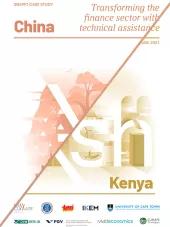The Global stocktake (GST), as outlined in Article 14 of the Paris Agreement aims to take stock of the implementation of the Paris Agreement, its purpose and long-term goals. The outcomes of the GST are intended to inform the enhancement of NDCs, and to find innovative forms of international cooperation to enable climate action. The GST therefore represents an important opportunity to inform future climate action given the inadequacy of the global effort to respond to climate change to date.
This report aims to respond to the research question: How do we understand progress on mitigation and adaptation actions in five countries? How might such actions enable countries to shift to pathways to more sustainable development and how can such shifts be supported by consistent finance flows (Art 2.1c) and provision of finance (Art 9)? What might be the role of the global stocktake in strengthening national action and international cooperation?
To answer these questions the report starts with an introduction to the GST and a literature review of trends in the provision of international climate finance. The report adopted a bottom up approach through the use of case studies to covers all elements of the GST (albeit to varying levels of depth) namely mitigation, adaptation, and support including finance and capacity building. The report culminates in a set of key messages for the GST to consider.
The study has explored the use of pathways as a way of illustrating where we need to go and how we might get there, and importantly how financing concrete activities through Articles 2.1c and 9 could be a way of strengthening the linkages between these articles to enhance collective progress toward long-term goals. Mitigation and adaptation pathways might be considered by the technical dialogue of the GST, testing whether people holding diverging world views might find common ground around pathways. Pathways are therefore of interest for this study in so far as offering a way of bridging articles 2.1c and 9. Just transitions to net zero emissions will require finance, as will increasing resilience to the impacts of climate change – and addressing loss and damage. Innovative finance is needed for inclusive, equitable climate resilient and low emissions development pathways.
Despite significant increases in climate finance over the last decade, there remains a large shortfall between the provision of ICF and the financing needs of developing countries. An expanded role for both the public and private sector in ICF provision will be necessary to meet the funding needs of developing countries. A disproportionate amount of ICF provision has been allocated to mitigation, which has meant limited finance has been allocated towards adaptation and loss and damage. Equity requires a balance between funding of mitigation and adaptation, and addressing loss and damage (iGST, 2021).
Two enabling factors for enhancing ICF identified by the literature review included international cooperation and metrics. International cooperation, has the potential to de-risk investments, ensure that financing needs are better articulated, and align incentives between stakeholders. Standardised reporting metrics and targets are necessary to ensure more efficient and equitable delivery of ICF.
The findings of the literature review were corroborated by the findings of the SNAPFI partner inputs. The following key messages emerged from the research. In general, the GST in taking stock of implementation could identify some technical guidance on standardising methodologies for reporting climate finance flows whilst also taking account of local circumstances, informing but not replicating the detailed work under transparency. Metrics for adaptation and finance for adaptation emerged as a key priority. This included the need to develop more shared understanding of the Global Goal on Adaptation (GGA) and develop appropriate adaptation metrics, as a way to clearly communicate the adaptation finance needs, tracking of progress on the goals and finance attracted. Metrics for adaptation are complex, and qualitative approaches should be considered in the GST, while quantitative metrics might not ‘aggregate’ in the same way as tons in mitigation or Euros in finance. Adaptation metrics to assess progress of action and support over time and process metrics, were some of the innovations that were identified. Lack of coordination between ministries within countries working on adaptation metrics continues to be an issue that requires attention. The GST could assist by collecting information on adaptation to assess which adaptation actions have been successful at attracting finance, and the level and type of finance attracted.
With the increasing attention on 1.5°C and the push for net zero GHG emissions, a possible tension has emerged for mitigation, prioritising long term goals over near term action or vice versa. This study found a disconnect between Long Term Low Emissions Development Strategies (LT-LEDS) and Nationally Determined Contributions (NDCs). It may be useful to think of LT-LEDS providing a long-term perspective on near-term action articulated in the NDCs, and as an opportunity to translate goals into pathways that can be used to crowd in finance through Articles 2.1c and 9. The GST in its efforts to take stock of progress, could seek to understand reasons for disconnect and discuss ways to enhance alignment between the short and the long term goals to enable just transitions to net zero GHG emissions.
The GST is particularly relevant for Article 2.1c as it is currently the only place where the question of alignment of finance flows is seriously considered under the UNFCCC (iGST, 2021). A detailed and precise set of guiding questions can help to systematically map available information, highlight gaps and critical areas where more research will be necessary. To advance on the definition and operationalisation of Articles 2.1c and 9, important questions for the GST include scope and sources in the sense of what counts as climate finance and whose responsibility it is to provide ICF (Article 9), as well as the reach of Article 2.1c and how this links to the mobilisation goal under Article 9. Agreement on common indicators, boundaries and metrics is imperative. One of the most important methodological gaps concerns the question of alignment of finance flows in the broader sense and how this can be measured considering in particular the need to access data from non-Party stakeholders and the challenges associated with forward looking metrics and scenarios. This is central for Article 2.1c but also relevant for Article 9 in order to be able to assess the consistency of mobilised finance with the Paris Agreement goals and its key principles.
A registry of demand and supply of climate finance might be considered by the technical review of the GST to draw on experience of matching action and support, while also relating this to the NDC registries for both adaptation and mitigation. Building a diverse range of capacities will be essential for enhancing finance and international cooperation, underlining the importance of the often-overlooked ability goal outlined by Article 2.1b. Such capacities will be needed for articulating support needs, developing metrics and using metrics to track progress. The GST should seek to characterise the capacity challenge in a granular way to identify specific capacities that should be treated as priorities moving forward.
Research at the country level shed light on how progress in countries is of relevance for the GST and the status of preparations for countries to participate in the GST. It was notable that none of the countries have initiated preparations for the GST and at this point in time, the purpose of the GST and countries’ participation in it remains unclear, suggesting additional work is needed to communicate the relevance of the GST for countries. This, the first GST is likely to influence the shape of subsequent GSTs and therefore design features are vital.
This study aims to provide insights as to how the GST could contribute to enhancing the role of climate finance and international cooperation.
NewClimate Institute contributed chapter 6.1.3 "Enhancing clarity and building the linkages between Art 2.1c and 9" to this report.





